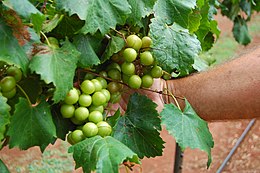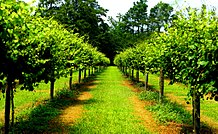Scuppernong
Scuppernong refers to a group of varieties of Weinrebenart Vitis rotundifolia , which in the southern states of the United States is based. In contrast to the mostly dark blue fruits of Vitis rotundifolia called Muscadins , the Scuppernong fruits are lighter, usually greenish or bronze-colored and resemble white noble grapes in their appearance and texture , but are rounder and about 50 percent larger than them. It is believed that it was the first grapes to be cultivated there.
In addition to juice, jam and jelly can also be made from the fruit . They are also used in North Carolina's viticulture . The sweet and often golden yellow wine made from them can be well structured. Its taste differs distinctly from wines made from European grapevines .
The name is reminiscent of the Scuppernong River in North Carolina , where the grapes were first discovered and cultivated by European settlers in the 17th century. However, the grape variety was probably already mentioned by Giovanni da Verrazzano when he was exploring the valley of the Cape Fear River . The name itself comes from the Algonquian language of the Native Americans and means “laurel tree - sweet bay tree” ( ascopo ). The word Ascupernung means as much as the place where Ascopo grows and mutated into today's Scuppernong in the 18th century.
Local importance
Scuppernong grapes are the state fruit of North Carolina and are therefore one of the symbols of the state. They are portrayed in the story The Goophered Grapevine (1887) by Charles W. Chesnutt and are also mentioned in the book To Kill a Mockingbird by Harper Lee . The vine is also used in William Faulkner's novel Absalom, Absalom! mentioned as a plant under which Colonel Thomas Sutpen and Washington Jones sit down to drink. In a poem by Elinor Wylie , the grape and its taste is also mentioned:
The winter will be short, the summer long,
The autumn amber-hued, sunny and hot,
Tasting of cider and of scuppernong;
Synonyms
Scuppernong is also known by the following names:
American Muscadine, Big white grape, Bull, Bullace, Bullet, Bullet grape, Green muscadine, Green Scuppernong, Hickman's grape, Pedee, Roanoke, White muscadine, White Scuppernong, Yellow muscadine.
Ampelographic varietal characteristics
The fruit consists of four parts: the outer skin, the pulp, seeds and the juice bound in the pulp. Several small green seeds can be found in every fruit, which, in contrast to the juicy, sweet pulp, taste bitter, but they can be eaten. The most popular part of the grape is the juice, which is mostly just below the skin.
In ampelography , the habitus is described as follows:
- The tip of the shoot is only hairy cobwebs.
- The small leaves are light green, shiny, thick and unbent (see also the article leaf shape ). The stem bay is open in a V-shape. The blade is bluntly serrated. The teeth are large and set wide in comparison to the grape varieties.
- The grape is small and very loose. The round berries are medium to large in size and green-yellow to bronze in color. The skin of the berry is thick. The aroma of the juicy berry is fine and has an aromatic bouquet with a light nutmeg taste.
Individual evidence
- ↑ Jancis Robinson : The Oxford Wine Lexicon. 2nd, completely revised edition. Hallwag, Munich 2003, ISBN 3-7742-0914-6 , p. 670.
- ↑ Elinor Wylie : Wild Peaches, Nets to Catch the Wind (1921)
literature
- Pierre Galet : Dictionnaire encyclopédique des cépages. Hachette, Paris 2000, ISBN 2-01-236331-8 .
- Pierre Galet: Cépages et vignobles de France. Volume 1: Les vignes Américaines. 2e édition, entièrement refondue. Paysan du Midi, Montpellier 1988, ISBN 2-902-771-03-7 .
- Jancis Robinson : The Oxford Wine Lexicon. 3rd, completely revised edition. Hallwag, Munich 2007, ISBN 978-3-8338-0691-9 .
Web links
- Scuppernong in the database Vitis International Variety Catalog of the Institute for Grapevine Breeding Geilweilerhof (English)
- American Grapes: Muscadines & Scuppernongs. Cooking portal The spruce eats (English)

